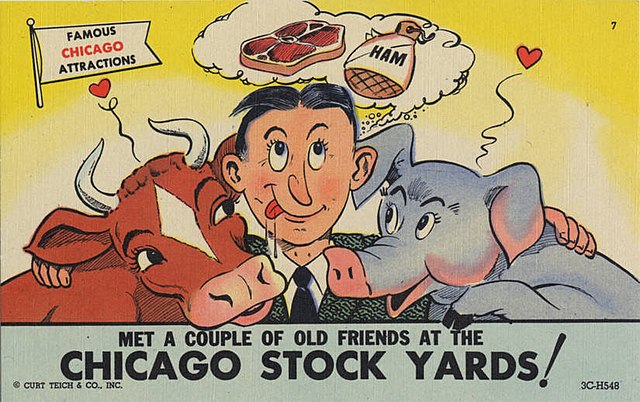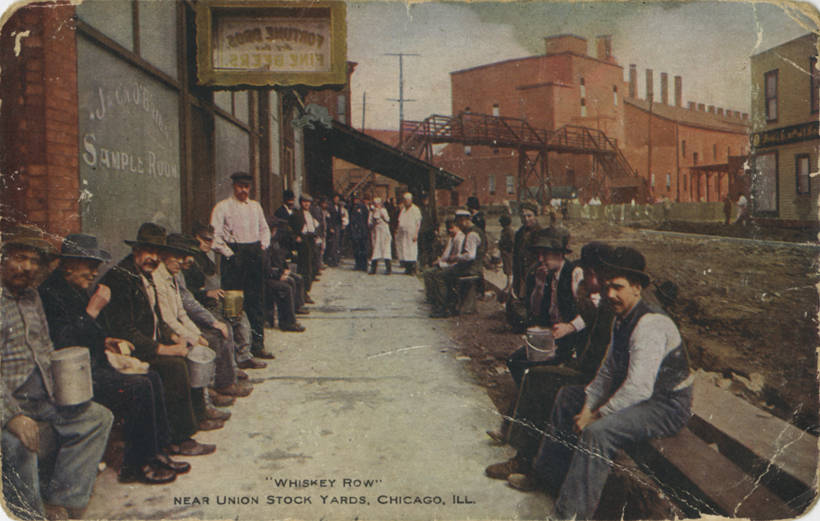Chicago
BY CARL SANDBURG
Hog Butcher for the World,
Tool Maker, Stacker of Wheat,
Player with Railroads and the Nation’s Freight Handler;
Stormy, husky, brawling,
City of the Big Shoulders:
They tell me you are wicked and I believe them, for I have seen your painted women under the gas lamps luring the farm boys.
And they tell me you are crooked and I answer: Yes, it is true I have seen the gunman kill and go free to kill again.
And they tell me you are brutal and my reply is: On the faces of women and children I have seen the marks of wanton hunger.
And having answered so I turn once more to those who sneer at this my city, and I give them back the sneer and say to them:
Come and show me another city with lifted head singing so proud to be alive and coarse and strong and cunning.
Flinging magnetic curses amid the toil of piling job on job, here is a tall bold slugger set vivid against the little soft cities;
Fierce as a dog with tongue lapping for action, cunning as a savage pitted against the wilderness,
Bareheaded,
Shoveling,
Wrecking,
Planning,
Building, breaking, rebuilding,
Under the smoke, dust all over his mouth, laughing with white teeth,
Under the terrible burden of destiny laughing as a young man laughs,
Laughing even as an ignorant fighter laughs who has never lost a battle,
Bragging and laughing that under his wrist is the pulse, and under his ribs the heart of the people,
Laughing!
Laughing the stormy, husky, brawling laughter of Youth, half-naked, sweating, proud to be Hog Butcher, Tool Maker, Stacker of Wheat, Player with Railroads and Freight Handler to the Nation.
New City
If you’ve been following my reports about the areas that saw an increase in closings in 2021 and 2022 you may have learned some of Chicago’s history that is perfectly painted in Carl Sandburg’s poem about the city. Our next area to explore is New City. New City is probably better known for the two neighborhoods that make up the area, Back of the Yards and Canaryville. Of course, his first line in the poem, “Hog Butcher for the World” refers to the Union Stock Yard, which at its peak controlled about ¼ of the Back of the Yards neighborhood.
The Union Stock Yard first opened on Christmas day, 1865 in the town of Lake. While the meat packing industry had previously been centered in Cincinnati southern trade was closed off in that city during the Civil War. At the time Chicago was becoming a central location for shipping due to a strong train system. Ongoing advancements in refrigerator boxcar designs made Chicago an excellent location for the meatpacking industry.
The area was annexed by Chicago in 1889 and developments of workingmen’s cottages sprang up. The area was originally settled by Irish and German butchers. With little access to transportation these workers wanted to live near their jobs. Between 1881-1905 the meatpacking industry saw the most strikes in any industry in the United States at the time, including an 1894 strike supporting the Pullman workers, who we learned about in March. During this time managers found that they could hire Polish workers as strikebreakers. This drove many of the Irish and German workers to move to Englewood and other neighboring areas. You may recall from my July post that in 1905 Englewood enjoyed its most prosperous year.
1906 was the year Upton Sinclair published his book The Jungle in which he describes the working conditions in the stockyards in grotesque detail. The unsanitary conditions were not solely contained within the plants. The entire Back of the Yards community was impoverished and polluted from the start. The nearby branch of the Chicago River is called Bubbly Creek because all of the waste dumped in it from the stockyards has caused it to bubble. These conditions led to gang activity starting with the Irish and German youths and evolving through time as different groups of nationalities moved in and out of the area.
Canaryville wasn’t immune to this either. Settled by clerks, cattle buyers, and managers, it has always strived to be more of a middle class neighborhood. However, a strong gang reputation was also established there.
The great depression hit the area hard and became the catalyst for neighbors to come together to advocate change in the neighborhood. In 1939 the Back of the Yards Neighborhood Council (BYNC) was created for this purpose. The organization is still active today, shepherding the area through societal and economic changes.
Increase in highway travel following World War II led to truck transport of meat and less of a need for a central hub. The Union Stock Yard closed in 1971 and has since been replaced with a very active industrial park.
For better or worse New City has been behind a surprising amount of Chicago history and in some ways completely embodies Carl Sandburg’s poem. Upton Sinclair’s book finally caused the US government to inspect the meatpacking plants and as a result enacted the Pure Food and Drug Act and the Meat Inspection Act. Crooked politicians paid gang members to do dirty tasks and as the kids grew older they followed into careers in politics. The BYNC was used as a model for community organizing across the country.
Today the BYNC continues to offer strong support for the whole community with programming for youths, adults, and seniors. New City is also a priority area for the INVEST South/West program which offers incentives for developers to improve the major commercial corridor at Ashland and 47th. As part of that program a new branch of the Chicago Public Library is being built. Vacant land is also being developed for affordable housing, youth programming, senior living, medical clinics, and park space
Although the two neighborhoods that make up the area are pretty distinct a strong community is very important to the area of New City. An equitable developer would do very well here. There is plenty of room for development and improvements while allowing the community to keep its strong personality. Next time you are in the area in the evening I encourage you to take a drive through Canaryville. I think, in the whole city, it might be the most decorated neighborhood for the holidays, all of them!

Chicago Stock Yards (NBY 417615).jpg
Sources:
https://www.poetryfoundation.org/poetrymagazine/poems/12840/chicago
http://www.encyclopedia.chicagohistory.org/pages/2218.html
https://interactive.wttw.com/playlist/2018/06/21/union-stock-yards
http://www.encyclopedia.chicagohistory.org/pages/99.html
https://kb.osu.edu/bitstream/handle/1811/102991/1/Thesis_Porkopolis_Hudson_Nuss.pdf
https://en.wikipedia.org/wiki/Refrigerator_car
https://www.lib.niu.edu/2006/iht1320636.html
https://interactive.wttw.com/playlist/2020/01/23/the-jungle-food-safety
https://www.chicagoganghistory.com/neighborhood/new-city/
http://www.encyclopedia.chicagohistory.org/pages/2218.html
https://www.chicago.gov/city/en/sites/invest_sw/home/new-city.html


 Facebook
Facebook
 X
X
 Pinterest
Pinterest
 Copy Link
Copy Link
